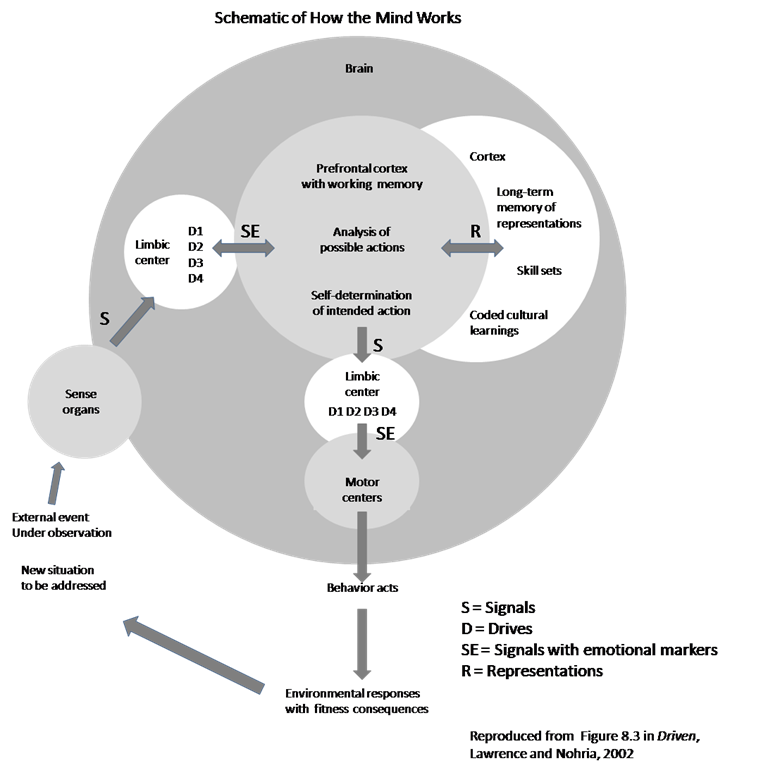
Lawrence, Paul R. and Nitin Nohria
What happens when you combine what we are learning about evolutionary biology with what we have learned about how organizations work? One of the wellsprings of thinking about organization and organization design has been the Organizational Behavior group at the Harvard Business School. The Hawthorne Effect was articulated based on the earliest research efforts of this group in the 1920s.
Paul Lawrence has been part of this group since the 1950s and Nitin Nohria has been part of it since the 1980s. Their laboratory has been large-scale organizations and their primary methods have been anthropological and ethnographic. They’ve been in the field observing how real people operate inside real organizations. In Driven, Lawrence and Nohria take time away from the field to reflect on that knowledge in the light of what others have been learning about evolutionary biology. The result is a fascinating and provocative book. Warren Bennis, in an Editor’s Note, describes it as a near perfect book "applying the truths of one domain, the biological and neurological sciences, to another, the embryonic and needy organizational sciences."
Instead of working with the overly simplistic theories of human behavior that seem to underlie most current business and economic thinking, Lawrence and Nohria develop a simple theory grounded in the biological sciences that may account for what we actually observe in organizations in the wild.
They propose an model of human behavior built on top of four fundamental drives. Each drive is distinct and like elementary particles in differing combinations they account for all the more complex behaviors we see in organizations. It’s a strong claim but Lawrence and Nohria make a strong case for why their hypotheses are plausible in light of what we do know. Moreover, they propose straightforward ways we could go about testing them.
The four drives they propose are:
- To acquire – both actual and reputational assets and power
- To bond – with other individuals and with groups
- To learn – new things and new skills
- To defend – the above against threats
Lawrence and Nohria draw on everything from fMRI studies to ethnographic accounts to establish that they choices are plausible. In the process, they take us through a powerful synopsis of what multiple scientists in multiple disciplines have to tell us about human behavior. In an effort to develop a unified theory, they pursue of strategy of triangulating from these multiple perspectives to close in on a likely underlying model.
Given this hypothesis of four fundamental drives, Lawrence and Nohria then turn their attention to how these drives interact with cognition and emotions to create behavior. They synthesize their model using the following schematic:
One of the more interesting aspects of this model is the central role that emotions play in decision making. Lawrence and Nohria believe that their fundamental drives operate through the brain’s limbic center. First, signals from the outside world are filtered through the drives and essentially prioritized in terms of their emotional relevance. Nothing gets through to the rational centers of the brain unless it has been tagged as emotionally relevant by one or more of these underlying drives. Second, emotions provide the motivating energy to translate thought back into action.
Although the principle goal of this book is to lay out a theory consistent with what we’re learning from the biological sciences, Lawrence and Nohria do draw on four broad case examples to test the essential plausibility of the emerging model. They examine GM, HP, Russia, and Ireland in terms of how their model helps interpret where these institutions have been and where they are likely to go. They do so in enough depth to make a plausible case for their model.
Lawrence and Nohria have been engaged in working out the implications of their model since Driven was first published in 2002. Lawrence is at work on a new book extended his thinking and developing materials can be found at http://www.prlawrence.com/. In the meantime, if you are trying to make sense of the complex world of the human animal operating in complex organizations, Driven ought to be at or near the top of your reading list. Warren Bennis made the following claim at the beginning of this book:
When you dig in and begin to understand the four-drive framework of human nature, I doubt that you will ever look at your organization, your work group, your world, your family in the same way. Or yourself, for that matter. I also doubt that you will cling to or be content with a simplified hegemony of one basic Uber Alles motive anymore; the sort of stuff we read in the pages of economic texts that venerate acquisition and self-interest exclusively or in the classic Freudian writings that elevate the psychosexual drive to the exclusion of others, or certainly in the faux-heroic pages of Ayn Rand
(Warren Bennis, Editor’s Note, pp. xiii-xiv)
I thought this was a bit of marketing puffery before I finished Driven. Since then, I think Bennis has it just about right. More and more, I am finding myself integrating the ideas from this book into my thinking and my practice.

![Reblog this post [with Zemanta]](http://img.zemanta.com/reblog_e.png?x-id=ce47911a-c0de-47c6-af17-8325c943a615)
 Following up on
Following up on